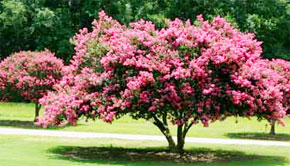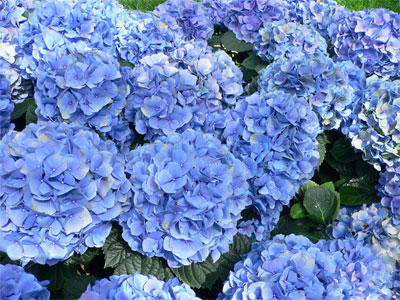Weekend Gardening: July Tips
July 20, 2019
The heat, humidity and frequent rains of July are great for tropical plants. Gardeners, however, take a bit of a beating. Remember to keep the sunscreen, insect repellant and iced tea handy as you venture out into your garden to perform some needed summer maintenance.
A midsummer application of fertilizer is usually required, especially on annual flowers, lawns, shrub beds and vegetable gardens. This is a supplemental application, so don’t overdo it. A 15-0-15 slow-release fertilizer is a good general purpose landscape fertilizer for most plants.
Major pruning jobs should have been done earlier, but there is still some maintenance pruning that should be done. Deadhead, or clip old flowers, from summer flowering shrubs as soon as they fade to help insure an extended season of bloom. Crape myrtles, hibiscus, hydrangeas and althea are examples of shrubs that will bloom repeatedly if light, selective pruning is done.
 Flowering annuals also respond well to deadheading. Snip off old flowers and flower spikes before they have an opportunity to form seed. Allowing annual flowers to set seed can shorten their blooming season considerably.
Flowering annuals also respond well to deadheading. Snip off old flowers and flower spikes before they have an opportunity to form seed. Allowing annual flowers to set seed can shorten their blooming season considerably.
Inspect your lawn and shrub plantings frequently in order to identify pest problems as early as possible. The most severe damage from pest insects normally begins in July. Be on the lookout for chinch bugs in St. Augustine grass; spittlebugs in centipede grass; sod webworm in all lawns-especially new ones; lacebug and caterpillars on azaleas; whiteflies on gardenia and spider mites on lots of different types of shrubs.
Sod webworms often attack lawns in the summer. They eat the grass blades producing areas that look as if they have been mowed too short. Close inspection will reveal that the blades have not been cleanly cut as with a mower blade but have been chewed along their edges and tips. These caterpillars feed at night and rest during the day down among the runners and in the thatch.
 Once an insect pest is found, evaluate the damage and determine if control is necessary. If it is, choose the least toxic option. If only a few caterpillars are found, hand picking might be the choice. Aphids and spider mites can often be controlled by spraying with an insecticidal soap solution. Chemical insecticides are sometimes required. Before choosing one be sure that the insect pest has been properly identified and that the insecticide is labeled for that purpose For vegetable gardeners that have problems with nematodes, soil borne diseases and extensive weed problems, July is a great time to try soil solarization.
Once an insect pest is found, evaluate the damage and determine if control is necessary. If it is, choose the least toxic option. If only a few caterpillars are found, hand picking might be the choice. Aphids and spider mites can often be controlled by spraying with an insecticidal soap solution. Chemical insecticides are sometimes required. Before choosing one be sure that the insect pest has been properly identified and that the insecticide is labeled for that purpose For vegetable gardeners that have problems with nematodes, soil borne diseases and extensive weed problems, July is a great time to try soil solarization.
Prepare the soil as you normally would for a vegetable garden including adding organic matter. Moisten the area and cover with clear plastic, not black plastic. Clear plastic will produce the highest temperatures. Be sure to weigh down the edges of the plastic so that it doesn’t blow up. Allow the soil to bake in the sun for four to six weeks. The sun will raise the soil temperature high enough to kill many soil borne problems.
Tip of the Week: The nice thing about tomatoes is that you have the option of harvesting when the fruit is green if needed. Tomatoes will ripen indoors at room temperature. To ensure even ripening, place the tomato with the stem up. The ideal time to harvest tomatoes is when they are fully colored but still firm.
In general, it is best to harvest vegetables early in the mornings while the moisture content is higher. The overall quality will quickly diminish as vegetables are exposed to hotter temperatures later in the day.
Comments
One Response to “Weekend Gardening: July Tips”



Whens the best time to prune grapes